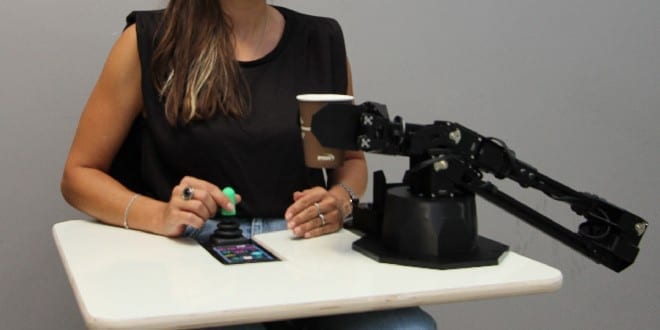More than 75 million people around the world are confined to a wheelchair on which the depend to have mobility. For those with neuromuscular or spinal-cord injuries that have weakened or paralyzed their arms and hands, even the most basic tasks – like drinking from a cup or eating with a spoon – are an elusive challenge. For such patients, the ability to reach and effectively manipulate objects one of their most important aims.
Assistive robotics can fill this gap. Studies have found that wheelchair-mounted robotic arms provide a greater sense of independence for users, and that these assistive tools can reduce the need for caregiver time by up to 41%. But these devices – whose parts must adapt to the user and the environment in real time – are very expensive, making them virtually inaccessible to most people who need them.
Intel and Accenture, an international innovation company with cross-industry expertise and a global network of over 100 innovation hubs, has just announced they are supporting an Intel Neuromorphic Research Community (INRC) project to develop wheelchair-mounted robotic arms for patients with spinal injuries. The project is being led by the Neuro-Biomorphic Engineering Lab at the Open University of Israel in collaboration with Jerusalem’s ALYN Hospital, which is acclaimed worldwide for its specialization in pediatric rehabilitation. ALYN is the only facility of its kind in Israel, focusing on the diagnosing and rehabilitating of babies, children and adolescents with physical disabilities, both congenital and acquired.
The robotic-arm device will be clinically evaluated and tested with children at ALYN. “Neuromorphic computing is a natural fit for assistive technologies, given its low power requirements and ability to learn and adapt to new situations in real time,” the partners said. “Through Intel and Accenture’s work with the Open University of Israel and ALYN Hospital, we hope to unlock new capabilities for mobility impaired children and improve the patients’ quality of life.”
HIGHLIGHTS
Intel officials explain that neuromorphic computing research emulates the neural structure of the human brain. The first generation of AI was rules-based and emulated classical logic to draw reasoned conclusions within a specific, narrowly defined problem domain. It was well suited to monitoring processes and improving efficiency. The second, current generation is largely concerned with sensing and perception, such as using deep-learning networks to analyze the contents of a video frame.
A next generation will extend AI into areas that correspond to human cognition, such as interpretation and autonomous adaptation. This is critical to overcoming the so-called “brittleness” of AI solutions based on neural network training and inference, which depend on literal views of events that lack context and commonsense understanding. Next-generation AI must be able to address novel situations and abstraction to automate ordinary human activities.
It will be based on the Loihi research chip, which includes 130,000 artificial “neurons” optimized for spiking neural networks. The main challenges in neuromorphic research are matching a human’s flexibility, and ability to learn from unstructured stimuli with the energy efficiency of the human brain. The computational building blocks within neuromorphic computing systems are logically analogous to neurons. Spiking neural networks (SNNs) are a novel model for arranging those elements to emulate natural neural networks that exist in biological brains.
Each “neuron” in the SNN can fire independently of the others, and doing so, it sends pulsed signals to other neurons in the network that directly change the electrical states of those neurons. By encoding information within the signals themselves and their timing, SNNs simulate natural learning processes by dynamically remapping the synapses between artificial neurons in response to stimuli.
To provide functional systems for researchers to implement SNNs, Intel Labs designed Loihi, its fifth-generation self-learning neuromorphic research test chip, which was introduced in November 2017. This 128-core design is based on a specialized architecture that is optimized for SNN algorithms.
Because the technology is still in a research phase and has not yet gone into production, only a limited number of Loihi-based test systems exist. To expand access, Intel Labs has developed a cloud-based platform for
The real-time learning capability of Intel’s neuromorphic research chip, Loihi, shows potential to reduce the cost of creating and operating such devices. By utilizing Loihi’s real-time learning, researchers predict they can implement adaptive control to enhance the arm’s functionality, while using affordable parts that could reduce the cost by more than 10 times. Loihi’s power efficiency also shows promise for making assistive technologies more useful and effective in real-world situations. Because Loihi is up to 1,000 times more energy efficient than general-purpose processors, a Loihi-based device could require less frequent charging, making it more ideal for use in daily life.
Edy Liongosari, the chief research scientist at Accenture, said, “This research project is a powerful demonstration of the impact that neuromorphic computing can have on the development of affordable intelligent assistive devices. Making these devices accessible, particularly to such young patients, can have a profound impact on their independence, improving the way they live. We are looking forward to teaming closely with the Open University of Israel researchers, ALYN and Intel, contributing our technical and industry experience to advance this technology for those who need it the most.”
“We believe that the development of a robotic arm based on neuromorphic computing can be a game-changer for people with disabilities. It could make it easier for them to engage with the community, boost their independence and grant them new employment opportunities,” said Arie Melamed-Yekel, general manager of ALYNnovation at ALYN. “We are proud to lead this revolution together with the Open University, Intel and Accenture.”
“The ability of robotic arms to benefit people today is largely limited due to high cost and excessive power consumption,” said Elishai Ezra Tsur, lead project researcher at the Open University of Israel. “We will be able now to explore the implementation of adaptive controls on neuromorphic hardware in an effort to address the need for a collaborative, user-friendly, accurate robotic arm at a significantly reduced cost.”



